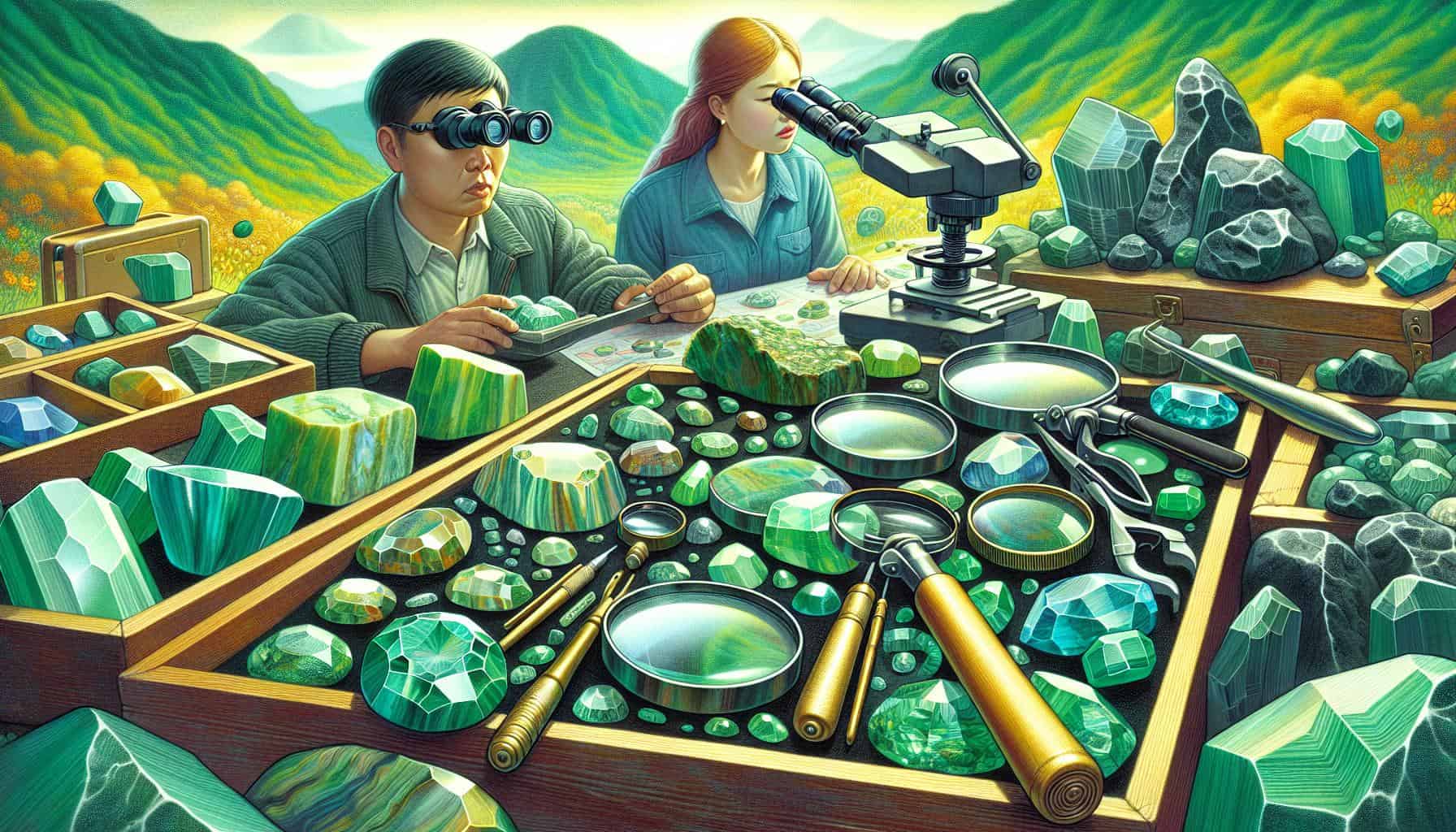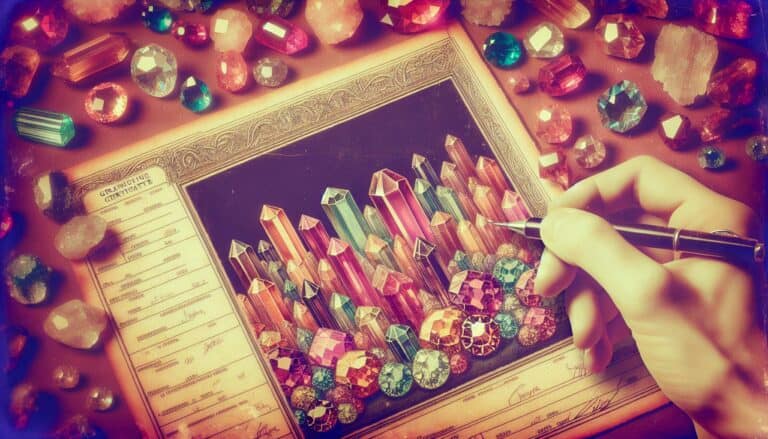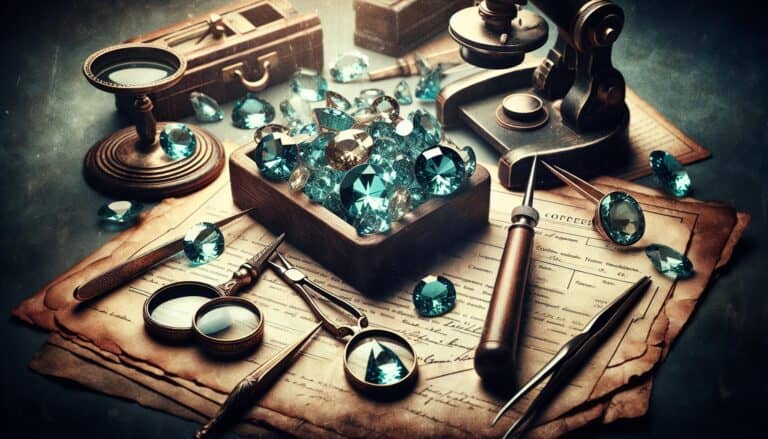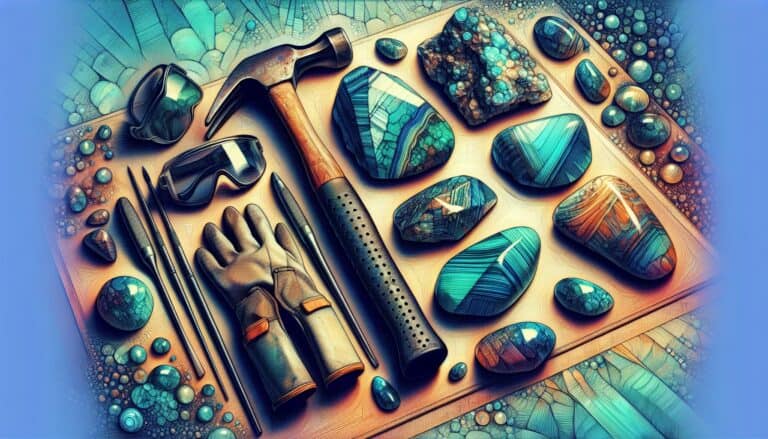Discovering the secrets of jade identification can transform your treasure-hunting adventures or refine your gemstone collection.
You’re about to learn how to distinguish real jade from the imitators with ease.
Whether you’re a seasoned collector or a curious newbie, knowing what to look for is key.
Get ready to become an expert in spotting the genuine article with tips that gemologists swear by.
Identifying jade involves visual inspection for its translucent green color, a white streak test, and checking for non-magnetic properties. Jade’s hardness on the Mohs scale is 6-7. It displays single refraction and no birefringence. Measure refractive index (Jadeite: 1.66-1.67, Nephrite: 1.60-1.65) and specific gravity (Jadeite: 3.30-3.50, Nephrite: 2.90-3.10) for confirmation.
How to Identify jade Through Testing
When you’re out hunting for that perfect piece of jade, knowing a few key tests will make your search both more efficient and more rewarding. Experts rely on several techniques to authenticate jade and separate it from clever imitations. With some practice, you’ll start to feel confident in your ability to identify jade through these common tests.
Visual Inspection
Begin with a thorough visual inspection under good lighting. Authentic jade typically exhibits a smooth, even texture and a vibrant yet translucent green hue. Inconsistencies in color might indicate dyeing, while bubbles or a glassy appearance hint at imitation materials. Use a magnifying glass to look for these subtleties:
- Uniformity of color
- Natural texture patterns
- Absence of bubbles
The Streak Test
Perform a streak test to examine jade’s composition. This involves rubbing the stone against a piece of unglazed ceramic to observe the trail it leaves. True jade will leave a white streak, while many fake stones will lack this distinctive mark. Keep in mind, though, this test might damage delicate specimens.
Magnet Test
Jade is not magnetic, so running a Magnet Test can sometimes reveal a forgery if ferrous materials are present. Never use this test on a piece that you’re worried might be easily damaged.
Hardness Test
As one of the toughest gemstones, jade has a hardness of about 6 to 7 on the Mohs scale. You can conduct a simple Hardness Test using a metal tool to see if it scratches the surface. If it does, what you’ve got is likely not jade.
Birefringence Test
A Birefringence Test involves looking at a stone through a polarizing filter to detect a double image caused by double refraction. Real jade does not have this optical feature, so any birefringence would indicate an imitation.
Checking The Diaphaneity
Assess the diaphaneity, or the gemstone’s transparency, by holding it up to light. Genuine jade usually allows light to penetrate slightly, giving a glowing appearance without being completely transparent.
Single or Double Refraction
Jadeite and nephrite, the two types of true jade, are single-refraction materials unlike cubic zirconia or glass. By using a refraction lens, you can usually determine whether your specimen refracts light singularly or doubly.
Refractive Index Test
Professional gemologists use a refractometer to measure the refractive index, a precise metric that identifies minerals. Jadeite has a refractive index between 1.66 and 1.67, and nephrite between 1.60 and 1.65.
Finding The Specific Gravity
To determine the specific gravity of a jade piece and differentiate it from fakes, you will typically need a special scale and hydrostatic weighing equipment. Real jade has a specific gravity range of:
| Jade Type | Specific Gravity Range |
|---|---|
| Jadeite | 3.30 to 3.50 |
| Nephrite | 2.90 to 3.10 |
Identifying Jades in the Field
In the field, identifying potential jade rocks can be tricky. Look for stones that have a hefty weight for their size as both jadeite and nephrite are quite dense. Search for rocks with a smooth surface and a waxy sheen, which are telltale signs of jade.
Recognizing Potential Jade Rocks
Potential jade rocks can come in various shapes and sizes, but typically they’ll have a notable solid feel and cool temperature to the touch. They also won’t scratch easily. Polished riverbeds, metamorphic environments, and serpentine-rich areas are prime locations for finding jade.
Physical Characteristics of jades

When you’re hunting for jade, keep a keen eye out for its distinctive physical characteristics. Jadeite and nephrite, the two varieties of jade, each have qualities that you can spot with a little know-how.
Jade’s color range is a significant indicator, varying from green to white, and even lavender to black. Traditionally, the most prized shade is a deep, translucent green. However, don’t overlook other hues as they can also denote true jade.
Texture plays a crucial role; genuine jade feels smooth and cool to the touch. A physical sign of jade’s dense structure is its hefty weight in your hand, disproportionately heavy for its size compared to ordinary stones.
Inspect the stone’s luster – real jade exhibits a waxy to glassy sheen. If your stone has a more vitreous appearance, it’s more likely to be jadeite, while a softer, waxy luster hints at nephrite.
When inspecting potential jade pieces, note the sound. Jade emits a resonant, musical clink when struck, distinguishing it from lesser stones that produce a duller thud. Incorporating these visual and tactile assessments will bolster your ability to specifically determine if you’re handling jade or an imposter.
Remember that jade’s overall allure stems from its unique combination of physical characteristics. Recognizing these traits is key in authenticating your jade findings. Keep in mind the delicate variations that may present themselves, and use them to guide your discernment.
How Are jade Formed?
Jade, a term that encompasses two chemically distinct minerals nephrite and jadeite, is formed through metamorphic processes involving high pressure and relatively low temperature. These conditions are typically found in subduction zones where oceanic plates dive beneath continental plates.
Nephrite originates from calcium and magnesium-rich amphibole mineral called actinolite. Its formation thrives in regions where tectonic activities have altered the protolith, or the original rock, into a densely packed, interwoven fibrous structure. This results in the toughness that nephrite is renowned for.
On the other hand, jadeite is created under even higher pressures but still at the low temperatures characteristic of the blueschist metamorphic facies. It’s primarily a composition of sodium and aluminum, and its crystallization depends on fluid dynamics within the Earth’s mantle, which transport the necessary elements that transform into jadeite.
As you explore potential jade deposits, you’ll likely find these stones in or near these geologically active zones:
- Along river bends where water has eroded the mountainous areas
- Within boulder clusters, as jade often remains after softer rock has weathered away
- Neighboring serpentine rocks, which are sometimes associated with jade formations
Understanding the geological birthplace of jade can enhance your ability to discern where quality deposits may be hidden, aiding significantly in identifying genuine pieces in the field.
Preparation for jade Hunting
Before you embark on your journey to uncover the treasure that is genuine jade, it’s important to arm yourself with knowledge and the proper equipment. This preparation is essential for both the success and safety of your jade hunting expedition.
Gathering the Right Tools
To maximize your chances of identifying and collecting real jade, you need to have the right tools on hand. Below is a list of essential items you should consider:
- Geologist’s hammer or rock pick: A must-have for chipping away at potential jade samples.
- Hand lens or magnifying glass: For close-up inspection of the stone’s surface and structure.
- Scratch test kit: Helps you check the stone’s hardness which is a vital jade identification factor.
- Moisture-resistant notebook and pencil: To record the location, appearance, and characteristics of your finds.
- GPS device or map: For tracking your exploration routes.
- Durable gloves: To protect your hands while handling rough rocks.
- Protective goggles: Safety comes first, and your eyes need guarding from flying debris.
Bringing along a jade reference guide, either in print or digital format, can provide on-the-spot verification and prevent you from overlooking important details. Pack these tools in a sturdy, comfortable backpack – you’ll be carrying it for a while.
Safety Considerations
When hunting for jade, never underestimate the importance of safety. Keep these considerations in mind to ensure a safe and enjoyable journey:
- Always tell someone your exact location and expected return time.
- Wear appropriate clothing including long sleeves, pants, and hiking boots to guard against abrasive rocks and vegetation.
- Carry sufficient water and snacks to stay hydrated and energized.
- Equip yourself with a first aid kit for unforeseen injuries.
- Be mindful of the weather forecast and prepare for sudden changes.
- Familiarize yourself with the wildlife in the area to avoid dangerous encounters.
- Avoid overexertion; know your limits and take breaks as needed.
By paying attention to these safety tips, you’ll maintain your well-being while focusing on the exciting task of uncovering genuine jade specimens in their natural environment. Remember, your safety is paramount when venturing into the wild in search of this exquisite stone.
Handling and Care of Found jades
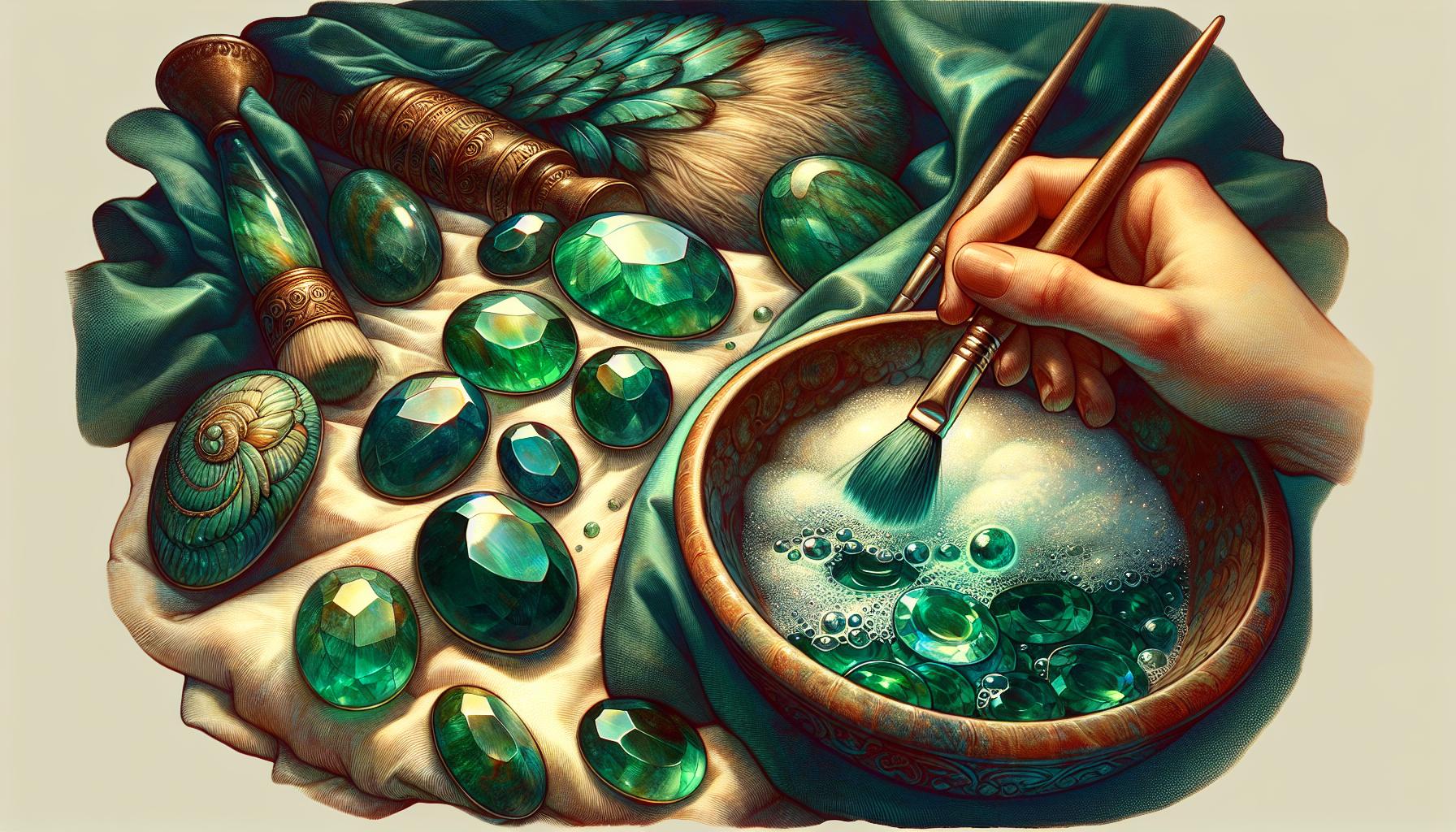
Once you’ve successfully identified and collected jade stones during your expedition, handling and care are the next critical steps. Proper procedures ensure your jades remain in pristine condition and retain their natural beauty and value.
Cleaning Jades
Your newly acquired jade treasures may have dirt or debris from the environment. It’s essential to clean them gently but thoroughly to avoid any scratches or damage. Use a soft-bristled brush and mild soap in lukewarm water to clean your stones. Avoid harsh chemicals as these may react with jade, altering its appearance and compromising its integrity. Here’s a simplified process:
- Rinse the jade in clean water to remove loose particles.
- Prepare a soapy solution with a pH-neutral soap.
- Gently scrub with a soft brush.
- Rinse again in clean water to wash away soap residue.
- Pat dry with a soft, lint-free cloth.
By doing so, you’ll reveal the true surface of your jade, preparing it for further analysis or display.
Storing Jades
Proper storage of jade is crucial to prevent scratches, chips, or other damage. Since jade is a relatively tough gemstone, it’s often assumed to be impervious to damage, but this isn’t the case. Here are some key storage tips to follow:
- Wrap each jade piece in a soft cloth or place it in a fabric-lined box to avoid contact with other gemstones or hard surfaces.
- Keep jade away from extremely high or low temperatures, which can cause it to crack or change color.
- Maintain a consistent humidity level to prevent jade from drying out and preserving its lustrous sheen.
Remember, your jade stones are not merely decorative items but are also cultural and historical artifacts. It’s your responsibility to care for them with the respect they deserve. Following these practices will not only protect but also enhance the longevity and beauty of your jade collection.
Conclusion: Confirming Real Jade
Armed with these expert tips and techniques, you’re now equipped to distinguish genuine jade from imposters.
Remember to conduct thorough tests, from visual assessments to scientific examinations, ensuring the authenticity of your find. When out in the field, trust your instincts but also rely on the characteristics of true jade—its weight, surface, sheen, and temperature. Always prioritize your safety by preparing adequately and using the right tools. Once you’ve secured your jade, handle it with care to preserve its natural allure.
Happy jade hunting, and may your efforts lead you to the real treasure!

